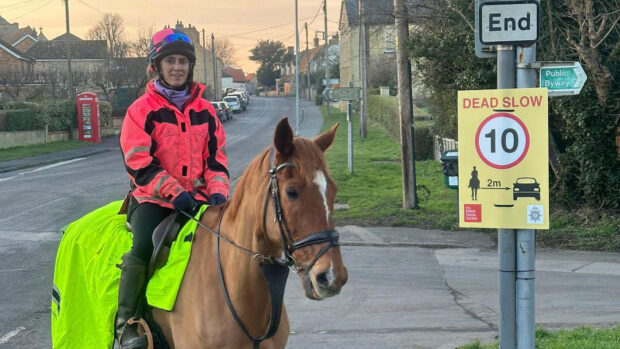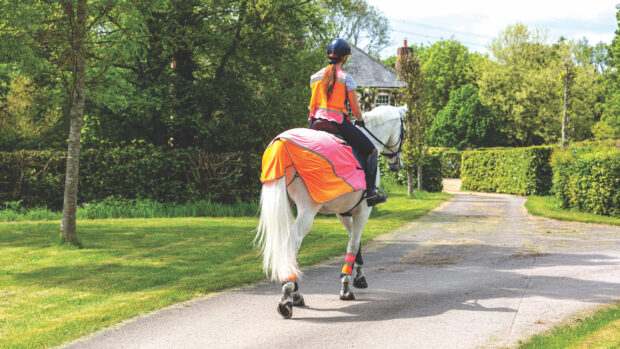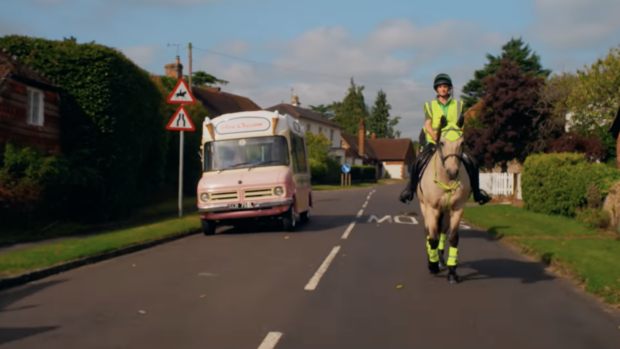EQUESTRIANS have been reminded of their responsibilities while riding on the road – from why high-vis is useful in court cases to the importance of thanking drivers.
In a webinar hosted by the British Equestrian Trade Association (BETA) on 20 August, as part of its Summer of Safety series, sergeant Zoe Billings of North Yorkshire Police and BETA chief executive Claire Williams discussed how risk on the road can be reduced for riders and drivers.
Sergeant Billings, a horse owner and former riding instructor, said she rides and carriage-drives on the road and has first-hand experience from both sides of the fence.
“I’ve been to fatalities involving horses and riders. I’m also that car driver that sees the behaviour of riders and how that can influence driver behaviour,” she said. “It gives me a little bit of concern that we as riders aren‘t necessarily doing all that we can to maximise our safety.”
The importance of being alert while riding on the roads and the use of mobile phones was discussed.
“The amount of riders in groups who are so engrossed in their conversation that the car ‘suddenly appears from nowhere’. If the first person who spots the car is your horse you should be embarrassed,” said Sgt Billings. “You should never be surprised if a car appears because they don’t appear from nowhere, and especially now with electric cars – they’re quiet. Don’t be reliant on hearing that engine sound.
“It is not an offence to use your phone when you’re riding but is it a good idea? Keep calls to a minimum or answer in emergencies, but consider a bluetooth earpiece.”
Sgt Billings said she advises against waving drivers round bends.
“Yes we have a good view in an elevated position but all it takes is for a bicycle to be coming round the corner that we haven’t seen. Let the driver make their own decision on what is safe for them,” she said, adding that riders should consider thanking all drivers.
“I hate going past horses where they don’t thank you. It’s about thinking, ‘How do we react to get the best out of the driver?’ Our action will influence their reaction, and you have to think that will influence their next action. If they haven’t slowed down enough, was it because the previous time they did they didn’t get an acknowledgement? It doesn’t help.
“If it’s safe to take your hand off the rein, brilliant. If it isn’t, use a big smile and nod. It will really make a difference and they will think about it. Obviously if they have put you in danger I’m not saying thank them, but it’s about showing that extra level of courtesy to elevate the perception of riders to being responsible, friendly and courteous on the roads.”
Sgt Billings said there are a number of myths around high-vis, including riders incorrectly believing that wearing high-vis is an admission of not being safe to be on the road.
“You want to maximise your conspicuity, stand out and smack them between the eyes in terms of ‘I am here to be seen’,” she said. “If the worst does happen, showing you are visible can assist in a criminal and civil court case. Criminally, if we can show that you were there to be seen, and still a driver didn’t see you – that could help tip the balance if that driver is prosecuted or not, if there is enough evidence.
“In a civil case, if you can show you have maximised your safety and reduced your risk as much as you can that can affect payout; it can make the difference between 100% or 50%. Suddenly a £5.99 slip-over high-vis doesn’t seem such a bad idea.”
British Horse Society director of safety Alan Hiscox, who took part in an earlier webinar to discuss the society’s road safety work and its role in the review of the Highway Code for vulnerable road users, said riders have to take their responsibilities seriously, and agreed high-vis “really does make a difference”.
“We had a report with the Transport Research Laboratory in 2017 which talks about drivers detecting horses, riders, carriage-drivers, and being able to judge their approach. We have scientific evidence now that says if you wear conscious clothing it really does increase your safety,” he said.
Ms Williams added that it is important that riders wear high-vis of the correct standard.
“A lot of people don’t realise that high-vis clothing isn’t just fluorescent clothing. It’s not just the fabric, it’s the retroreflective tape that reflects lights and as a riders you need to check when picking that high-vis it meets the appropriate standard. That means it passes tests on washability and durability. A bright orange jacket is not necessarily a piece of high-vis, though it probably helps make you be seen on the road.”
- What do you think about rider responsibility for road safety? Send your thoughts to hhletters@futurenet.com, including your name, nearest town and country, and you could win a bottle of Champagne Taittinger
You might also be interested in:

Why we riders have to take some responsibility for our own safety on the roads *H&H Plus*
Equestrian trade’s post-Covid recovery appears better than feared *H&H Plus*

Shocking pictures of ‘invisible’ horse show importance of high-vis on roads
“If sharing these pictures makes one person think about wearing high-vis, it’s worth it”

Help your horse stand out with these hi viz essentials

Subscribe to Horse & Hound magazine today – and enjoy unlimited website access all year round
Horse & Hound magazine, out every Thursday, is packed with all the latest news and reports, as well as interviews, specials, nostalgia, vet and training advice. Find how you can enjoy the magazine delivered to your door every week, plus options to upgrade to access our H&H Plus online service which brings you breaking news as it happens as well as other benefits.





